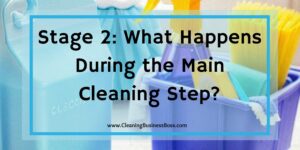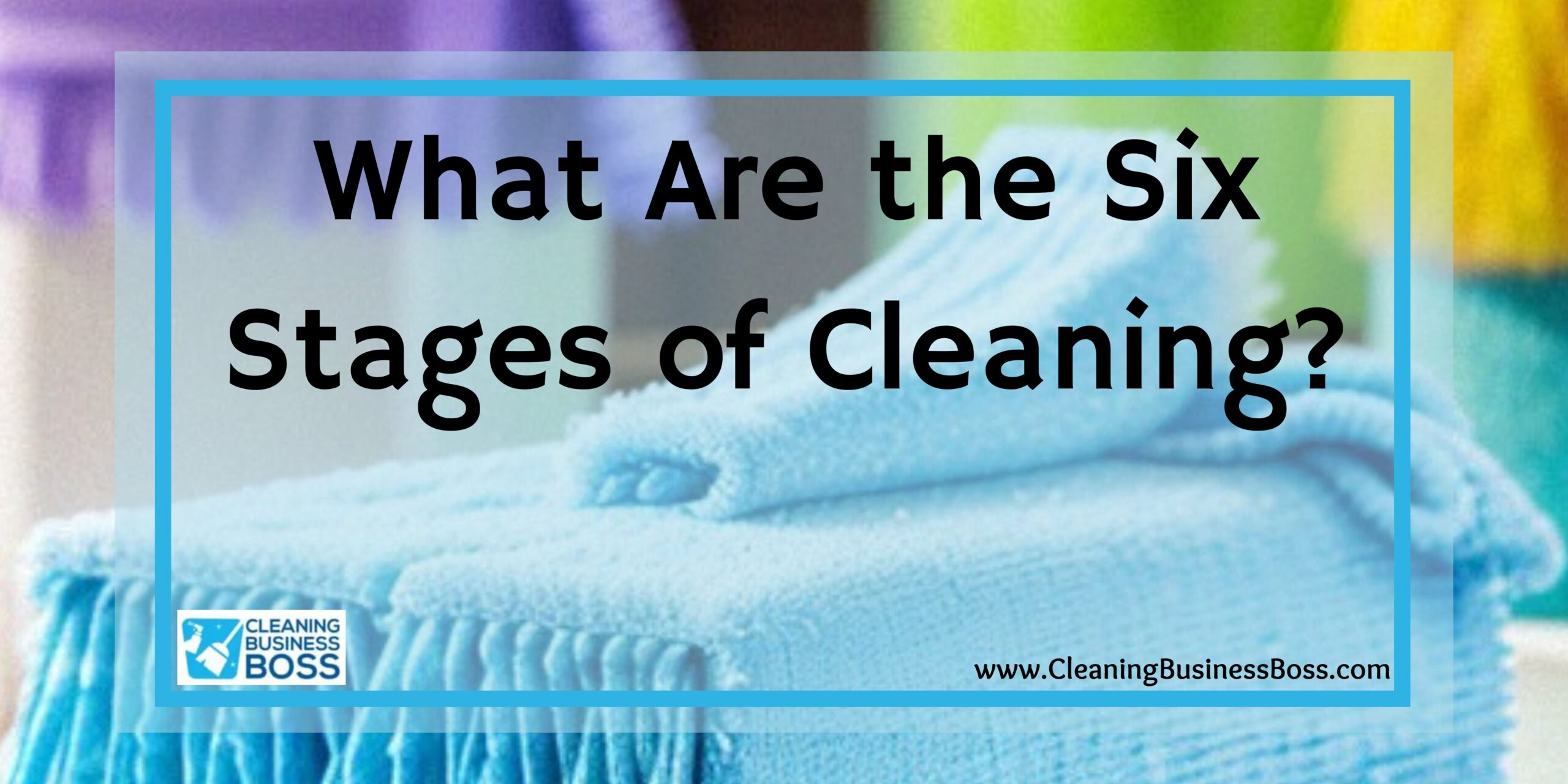Cleaning your home or office does so much more than provide you with a neat and orderly place to work or live. The most important reason for cleaning is to rid your home or workspace of germs, bacteria, and other contaminants that pose a risk to your health and the health of others. Having an established and effective cleaning process can ensure that you, your family, and your coworkers are living or working in the cleanest environment possible. If only there was a specific set of steps that can walk you through the cleaning process.
The six stages of cleaning include:
- Pre-Clean
- Main Clean
- Rinse
- Disinfection
- Final Rinse
- Drying
In this article, we will closely examine the six steps of the cleaning process, and why each step is an important piece of a complete cleaning. I will also provide you with a detailed description of each step, as well as the reasons why each step is essential to giving your home or office building the deep, thorough cleaning that it needs and that you, your family, your friends, and your coworkers deserve.
Stage 1: What Takes Place in the Pre-Cleaning Phase?
Remove loose debris and substances from contaminated surfaces.
This step sets the stage for how efficiently and how effectively you will be able to clean an area. A good pre-cleaning will remove most of the loose dirt and debris from the contaminated surfaces that are in dire need of a thorough cleaning. While most there are a few people who believe that this step isn’t necessary, most cleaning professionals will not only tell you that this step is highly recommended, but it is also necessary.
So, exactly how important is the pre-cleaning step of the cleaning process? The website FAMOS states that pre-cleaning drastically reduces the number of contaminants in the home or workplace. Pre-cleaning in the workplace has also been directly linked to increased worker satisfaction because workers feel much safer in a cleaner environment. Remember that the more attention gives to this step, the easier the rest of the cleaning process will be for you.
Check out this article to know what is basic cleaning.
Stage 2: What Happens During the Main Cleaning Step?

Loosen any substances, dirt, grease, and debris that you were unable to remove during the pre-clean stage.
This is another aspect of the cleaning process that is quite important. Once you are finished with the pre-clean step, it’s time to incorporate the use of detergents and other cleaners to remove the rest of the dirt, grime, and debris that are left on the surfaces you need to clean. If your pre-clean was done properly, the contaminants that are left will easily be wiped away with a mop for the floors, or a cloth for all of the other surfaces.
This is also the step that gives your home that fresh smell and sparkling appearance that inspired you to clean in the first place. As I’m sure you are already aware, people tend to feel much more comfortable in clean spaces. This is true in both the home and in the office. According to the website Namoli, a cleaner work environment improves the employees’ sense of health and well-being. Germs and bacteria thrive in dirty environments, and the main cleaning phase of the cleaning process is the first step to eliminating these contaminants.
Stage 3: How Do I Properly Rinse an Area?
Remove all the substances, dirt, and debris as well as the detergent used to clean these surfaces.
The main cleaning phase of the cleaning process will usually leave some detergent or other cleaners behind. That is where a good rinsing comes into play. This step of the cleaning process will require you to wipe your freshly cleaned surfaces with a rag and hot water. You can also do the same with a mop and hot water to remove any cleaner that may have been left behind once you have finished mopping.
This step is also important for the safety of your family, friends, or coworkers because it prevents the residual buildup of detergents and cleaners over time. According to the Metal Powder Report, good rinsing helps to optimize the cleaning process and is an essential step to achieving a higher standard of cleaning. While cleaning is defined as the removal of dirt and other contaminants, rinsing is the removal of cleaners that have the potential to build up over time.
Stage 4: What is Included in the Disinfection Phase?
Destroy all of the germs and bacteria that remain on these surface areas.
While every step of the cleaning process is highly important, the disinfecting step is arguably the most important. This is because the disinfecting step is the point of the process when you directly attack the germs and bacteria that are lurking in your home or office space. To give you an idea of how important disinfecting is, ZME Science states that there are over 2,000 species of fungus and over 7,000 species of bacteria in the average home.
The home isn’t the only place where bacteria lurks. It also runs rampant in the workplace. EHS Today states that there are over 10 million bacteria just in the space where your hand rests on your desk. These germs and bacteria can be directly responsible for getting you, your friends, your family, and your coworkers sick. Make sure that you are disinfecting with either heat or a chemical disinfectant that is highly effective at killing any hidden microorganisms on all of your surfaces.
Stage 5: What is the Purpose of the Final Rinse?

Remove all of the remaining disinfectants with hot water.
The rinsing phase of the cleaning process is so important that it is recommended that you do it twice. The purpose of the final rinse is to remove any of the chemical disinfectants that remain after the disinfection phase. If they are not properly and thoroughly rinsed away, these chemicals can spell trouble for the people that live or work in the area you just cleaned. You have invested a lot of time in ensuring that you provide a clean and safe home or office. The final rinse ensures that you have done exactly that.
Just like with the first rinsing step, the final rinse should be completed by using clean, hot water and a lean cloth. If you are not using clean cloths and hot water during the final rinse, you are not completely removing all traces of disinfectants, which has the potential to cause serious harm to your family, friends, and coworkers if accidentally ingested. Once you have finished with the final rinse, your surfaces should be sparkling clean and safe for everybody with whom you are sharing the space.
Know what are the types of cleaning for a cleaning business by checking out this article here.
Stage 6: How do I Ensure that the Drying Step is Properly Done?
Remove all water from surface areas either with drying cloths or by air drying.
The drying step is the final step of the cleaning process. Once you have completed the previous five steps of this rig, it’s time to make sure that you use a clean, dry cloth to remove any remaining water from all of your freshly cleaned surface areas. To dry any floors that you have just finished mopping and rinsing, you can either use a dry mop to ensure that they are completely dry, or you can use a fan if you prefer to air dry your flooring or surfaces. I would recommend using clean, dry cloths instead of air drying unless you have the luxury of allowing floors to dry overnight.
Perhaps the most important reason for drying all of the areas you have cleaned is that mold and bacteria thrive in damp areas. We have already covered how important it is to remove as much bacteria as possible when cleaning.
The last thing that you need is to leave damp areas in which they can thrive. Safety is yet another important reason for ensuring that all surface areas are properly dried. Wet areas can cause slips or falls, which have the potential to lead to serious injuries. All of these things can be prevented simply by making sure that you thoroughly dry all of the surfaces you just cleaned.
Summary
If you want to ensure that you are cleaning your home or your office properly, you must be sure that you follow all the Six steps of the cleaning process. In this process, the first thing you should do is to pre-clean all of your surfaces. Next, you will follow through with the main cleaning stage.
After you have finished with the main cleaning, you will need to rinse the detergents and cleaners from these areas. Next, you will need to move forward with disinfecting your home or office building. This step is the most essential because it eliminates almost all of the germs and bacteria that can make others sick.
The final rinse comes next, making sure that you remove all of the disinfectants you previously used. Failure to follow through with steps can lead to serious health risks for everybody involved. The drying step is the final step of the cleaning process.
Making sure that all surface areas are completely dry can prevent additional bacteria from growing, as well as prevent dangerous slip and fall accidents. Once you have finished all six steps, you will be left with a sparkling clean home or office that you will be proud to share with your family, friends, and coworkers. Trust me when I say that they will thank you for it.
Frequently Asked Questions

What is the best way to disinfect your home or your office building?
Two methods are quite popular when it comes to disinfecting your home or your office building. These methods are fogging and disinfecting with an electrostatic sprayer. While both methods are effective, electrostatic sprayers are far more efficient, being able to cover larger areas in a shorter period of time. They also make less of a mess than traditional foggers.
What type of carpet cleaning works best for commercial cleaning?
The methods of carpet cleaning that are used more often than any other methods are steam cleaning and dry carpet cleaning. Steam cleaning is one of the oldest methods of cleaning carpet. However, when it comes to cleaning commercial carpets, dry cleaning is said to be the best for high-traffic areas because of its versatility. Dry cleaning not only provides you with a deeper clean, but it also has no drying time.
Besides chemicals, what are some other methods of disinfecting my home or office?
Most of us are aware that there are chemical disinfectants that boast of their capability to eliminate up to 99 percent of bacteria and germs from household surfaces. However, the Center For Disease Control (CDC) has approved the following methods for disinfection and disease control:
- Ionizing Radiation
- Dry-Heat Sterilizers
- Performic Acid
- Filtration
- Microwaves
- Vaporized Hydrogen Peroxide
- Ozone
- Glass Bead Sterilizer
To learn more on how to start your own cleaning business, check out my startup documents here.
Please note that the contents of this blog are for informational and entertainment purposes only and should not be construed as legal advice. Any action taken based on the information provided in this blog is solely at your own risk. Additionally, all images used in this blog are generated under the CC0 license of Creative Commons, which means they are free to use for any purpose without attribution.

About the author. Entrepreneur and Cleaning Business Fan.
Hi! I am Shawn and I am a happy individual who happens to be an entrepreneur. I have owned several types of businesses in my life from a coffee shop to an import and export business to an online review business plus a few more and now I create online cleaning business resources for those interested in starting new ventures. It’s demanding work but I love it. I do it for those passionate about their business and their goals. That’s why when I meet a cleaning business owner, I see myself. I know how hard the struggle is to retain clients, find good employees and keep the business growing all while trying to stay competitive.
That’s why I created Cleaning Business Boss: I want to help cleaning business owners like you build a thriving business that brings you endless joy and supports your ideal lifestyle.


